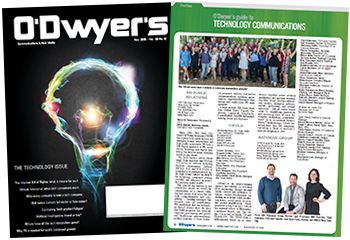 Shruti Sehgal and Dan Levitan co-authored this article. |
Farhad Manjoo caused a small uproar two years ago when he announced that the age of exciting new consumer technology — the so-called “gadget era” — was over. But is it really?
Americans will still spend more than a record $377 billion on new consumer technology this year. Over 20,000 consumer electronics products are launched at the International Consumer Electronics Show in January each year. Despite the tech crisis we keep reading about, we’ve seen neither a slowing of sales nor a reduced number of product launches. In fact, nearly one in five Americans owns a smart home speaker in 2018, a year that saw the rise of artificial intelligence, voice-enabled technology and the beginnings of 5G, Jetson-level innovations, some might say. So, what gives?
New consumer technology isn’t dead, not to average consumers like me and you, anyway. But writing about it is becoming boring to the people who have to constantly write about it. With the speed of new technology comes the speed of competition. More and more products are trying to reach the same consumers. And while more choices for consumers is a good thing, it should come as little surprise that one of the most common refrains we heard from reporters this past year was that they were tired of covering more of the same types of products.
Whether you’re a startup or a publicly traded company, you have likely experienced the challenge of trying to get your products to stand out. Culled from our experience with the clients, partners and reporters we’ve worked with over the past year, below are a few insights from BerlinRosen’s consumer technology and innovation practice on how to cut through the clutter.
Make your launch exciting
Tech companies have long relied on presentations in the form of press conferences and trade show keynote addresses to unveil their products. These presentations tend to follow a very similar format. But, as Business Insider’s Dave Smith points out, “The fact is, if you follow the news at all in 2018, it’s rare to witness a tech presentation that features legitimate surprises. And if there are no surprises, what’s the point of the presentation?” To build more media excitement around a product launch, consider surprises that will build consumer momentum, like unexpected product news, promotions and deals or partnerships.
It’s also important to give as much thought to how you debut your product on YouTube and Instagram: 57 percent of consumers say they first heard about the products they buy on social media. YouTube, in particular, makes up a third of all internet viewership and is second only to Google as the most popular search engine.
Embrace the competition
Consumer electronics remain one of — if not the most — highly researched product categories. People do their homework. That’s why tech reviewers cut right to the chase: Why and how is your product better or different than the competition? Often, tech companies, especially startups, are reluctant to talk about their products in the context of their competitors, considering their own product a whole new category or disruptor. While recategorization might sound persuasive in an investor pitch, it is far less persuasive when trying to land a strong product review. Reviewers want to make product comparison shopping easier for their readers and viewers. It’s their job. And most prospective customers won’t buy your product because you re-invented the sleep mask, but they will buy it if it works better than all of the other sleep masks out there. If you don’t want to be directly quoted acknowledging your competition, which is a fair point we often hear, at the very least be prepared to explain to your reviewer how your product stacks up directly against your competitors. Make them a cheat sheet on how your product compares to competitors to help them save a step.
Demonstrate impact
Your product is best understood through everyday examples that are easy to explain, demonstrate and prove. If these examples are easily replicable, say in a video that can be widely shared on social media, even better.
Tech companies sometimes have a misconception that consumers (and reporters) care most about product specifications, whether that’s the amount of RAM in a laptop, the processor speed of a smartphone or the megapixels in a camera. But in our experience, the strongest product endorsements come from tech reporters and reviewers who can easily show their readers or viewers how the product helped them solve a real pain point in their own lives. In other words, how do these increased specs make a difference for people or help solve a common problem? Answering either of these questions may not always require the most cutting-edge technology or innovation. One of the best examples we’ve heard from a reporter was how a simple function in a new camera made it easier for her to show her new apartment to her mom living across the country.
Prove you’re popular
Media fatigue poses a unique problem during the holiday season when companies have already launched their products and reporters have already covered them. But when it comes to sales, getting the word out about your products matters a lot more in the fourth quarter — still the largest sales moment for consumer electronics — than at any other point during the year. Tech companies often struggle to sustain media coverage around their products after they have been launched because they lack new product information to share. But that’s not entirely true. Tech marketing teams know the value of strong customer reviews. Studies have shown that one customer review can boost sales up by 10 percent and 50 reviews can increase sales by up to 30 percent. Sharing your customer reviews with reporters can help get your product included in listicles and round-ups, which are valuable to have placements in, especially online as more consumers look for quick resources to inform their holiday gift purchase decisions. Softer news moments — like consumer promotions and deals or where and how to take advantage of them — are also more likely to get air time or earned media coverage at the end of the year as reporters look for new holiday shopping content, making it easier for PR to supplement your holiday marketing plans.
***
Shruti Sehgal is vice president and Dan Levitan is senior vice president at BerlinRosen.



 Laura Anderson, who rose to VP/GM of global communications and events in a nearly 20 year stint at Intel, will take on the Americas technology chair at Burson following the completion of the BCW and H+K merger on July 1.
Laura Anderson, who rose to VP/GM of global communications and events in a nearly 20 year stint at Intel, will take on the Americas technology chair at Burson following the completion of the BCW and H+K merger on July 1. WE Communications has partnered with ROKK Solutions to form the WE ROKK AI service.
WE Communications has partnered with ROKK Solutions to form the WE ROKK AI service. In the dynamic world of modern business, effective communication is a pivotal tool for success across various industries. At Communications Strategy Group (CSG®), our expertise in embracing innovation in communication extends beyond traditional marketing strategies, paving the way for transformative industry-specific solutions.
In the dynamic world of modern business, effective communication is a pivotal tool for success across various industries. At Communications Strategy Group (CSG®), our expertise in embracing innovation in communication extends beyond traditional marketing strategies, paving the way for transformative industry-specific solutions. There are two types of tech PR professionals. Which one are you? And are C-suite executives making that decision for you?
There are two types of tech PR professionals. Which one are you? And are C-suite executives making that decision for you? While there’s an impulse to grab reporters’ attention with the newest industry-transforming tech product or service, a back-to-basics approach focused on telling the right stories to the right people is a far more successful way to ensure your technology campaign breaks through the clutter of today’s crowded tech landscape.
While there’s an impulse to grab reporters’ attention with the newest industry-transforming tech product or service, a back-to-basics approach focused on telling the right stories to the right people is a far more successful way to ensure your technology campaign breaks through the clutter of today’s crowded tech landscape.


 Have a comment? Send it to
Have a comment? Send it to 
No comments have been submitted for this story yet.